|
David's Astronomy Pages (All Sky)
AllSky Camera
|

Latest AllSky |
|

All Sky
Page |
|

Home
Page |
|

Aurora
Watch |
|
Since 2014 I have been running an
AllSky Camera that takes 180° all-sky
pictures continuously during the hours of darkness. My site has a
clear view of most of the sky.
The AllSky Camera's main roles are the support of
Observatory Operations (providing an
automatically generated Star Count and Cloud Cover estimate in particular) and for recording Aurora.
The camera has recorded a number of other atmospheric phenomena during its
years of operation (such as Bollides,
Meteors,
MoonBows,
Light Pillars,
NLC,
Lightening & other Weather ) together with a range of
insects & birdlife.
| Bright Meteor in NW Sky at 2023-11-30 17:21 UT |
| |
 |
North Sky Panoramic Image
30s exposure (single frame)
2023-11-30 17:21:00 to 17:21:30 UT
Oculus AllSky Camera |
Back to Top
The AllSky Camera that I have is a Starlight eXpress Oculus 180deg Camera.
The camera core is based on the 1.4 megapixel ‘SuperStar’ and it employs a
1.55mm FL f2 ‘Fish-Eye’ lens to achieve 180°. It is supplied in
a weatherproof housing with high quality polycarbonate hemisphere.
It is mounted on a mast which located
directly next to the observatory and connected back to a dedicated
AllSky/Weather Computer via a USB 2.0 cable.
I use my own software (AstroAllSky) for the
automated control and processing of images
from the camera.
My version of the camera is a 180° model which can
see from horizon to horizon, but it is also available as a 150° model
(which has a 2.5mm f1.2 150 degree ‘Fish-Eye’ lens giving a higher
resolution coverage of a smaller FOV). The camera takes
monochrome images only.
Basic Method.
The All Sky Camera takes 180° all-sky pictures
continuously every 30s during the hours of darkness (Exposures are
ramped up/down to 30s at dusk and dawn to allow for the change in sky
brightness). Data is processed in realtime, and panoramic pictures in
different directions (N,S,E,W & 360) are
created from the original fisheye images. Pictures are
automatically annotated with date/time and other informations, including named
stars, and automatically uploaded to website at
intervals through the night (AllSky Images).
Videos of AllSky Fisheye View and Northern Sky Panoramic View are automatically generated
and uploaded each morning (AllSky
Video).
The camera position and geometry are calibrated, such that north position,
zenith and image scale is determined. Az/Alt (and RA,Dec) can be computed
for a given x,y position in the image. Similarly the X/Y position can be
computed for a given Az/Alt psoition (or given RA,Dec position). Star-like
objects in the image can be automatically determined and counted. Also by
calculating their Ra/Dec positions they can be cross-referenced against a list
of known bright stars and planets , and automatically labelled. A
digital mask can be optionally overlaid over the moon position to reduce the
brightness of the moon and its glare in images.
The camera has just enough resolution and sensitivity to pick up the M31
Galaxy in Andromeda when it is sufficiently high in the sky, but this
is not normally visible in standard images from the camera when reduced down
to a 75% scale.
|
|
| |
AllSky Camera & Cloud Sensor Mast
(mounted on mast on the north side of the Dome) |
|
AllSky Camera / Cloud Sensor Closeup |
 |
|
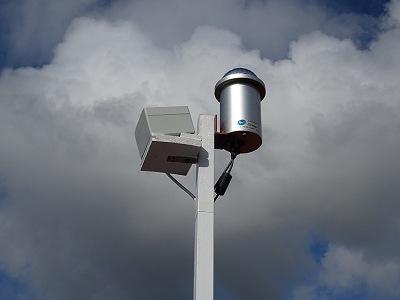 |
| |
|
|
AllSky Camera
(Camera poking above the observatory
roofline,
camera is mounted on mast on the north side of the Dome) |
|
AllSky Camera Closeup |
 |
|
 |
| |
|
|
| Pictures
of AllSky Camera on original mast, 2013-12-29 |
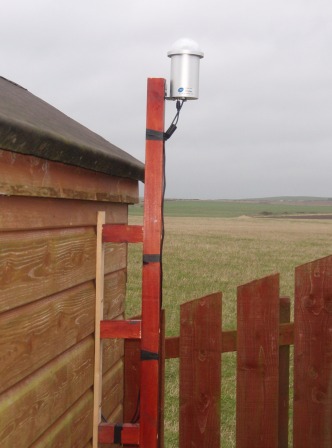
|
|
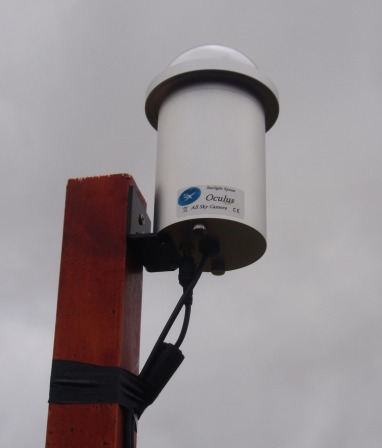
|
|
|
| First Light Test
(Indoors) - 2013-12-27
|
|
First Light Test
(Outdoors on Tripod) - 2013-12-28
|
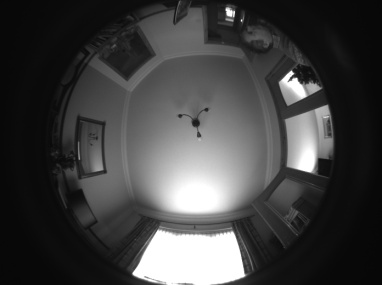
|
|
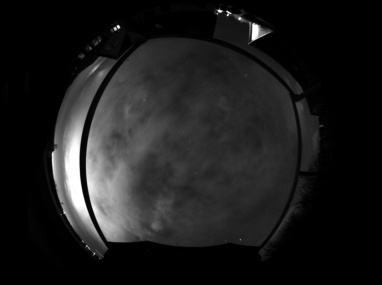
|
| 0.1s exposure, 2x2
binning, 55% scale (#06)
|
|
20s exposure, 1x1
binning, 27% scale (#00000001)
|
| |
|
|
First Light Image from
Oculus All Sky Camera in Permanent Position -
2013-12-29
(software written to collect image from Oculus Camera via CCDSoft
and create JPEG image with annotation automatically added in realtime)
|
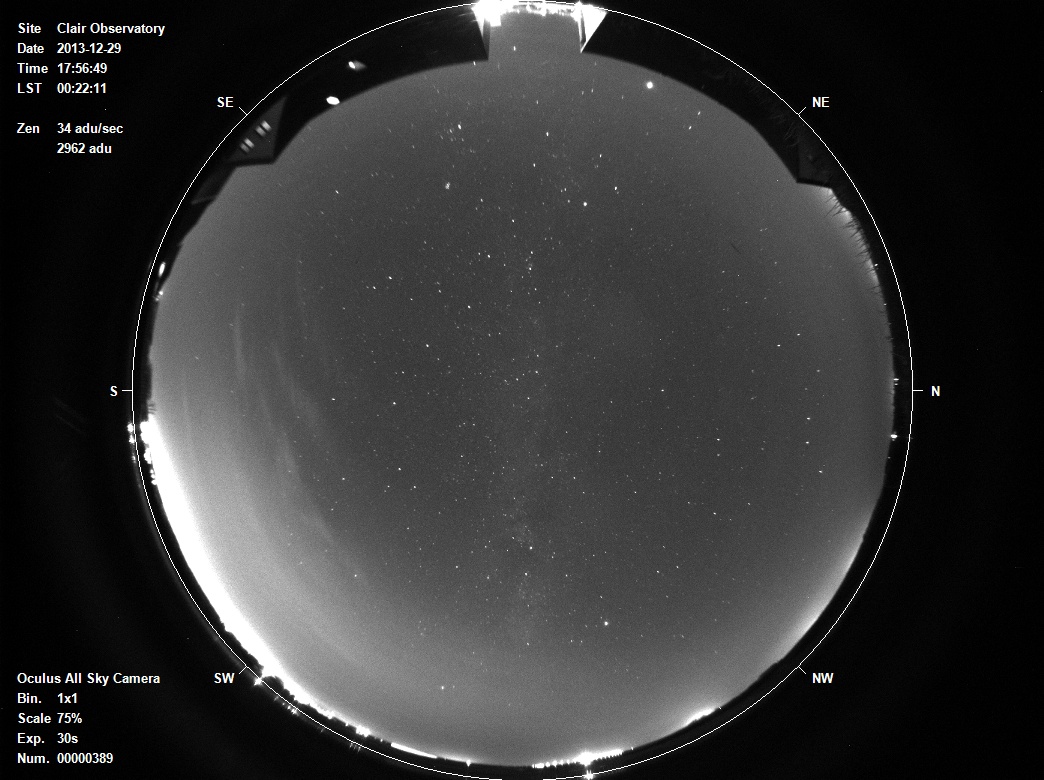
|
30s exposure, 1x1
binning, 75% scale
2013-12-29, 17:56 UT (#00000389), LST 00:22
Oculus All-Sky Camera, 180° lens
|
|
|
| Alignment Check
confirms that long axis of image is aligned precisely North-South
|

|
|
|
First Light Image -
Panorama
Geometry projected using IRIS software package, Sky Glow from
Local City and villages
|

|
|
|
First Light Image -
Detail (100% scale, cropped)
Stars sharp at zenith but become increasingly distorted (radially
stretched) at lower altitudes
M31 (Andromeda Galaxy) is recognisable
|
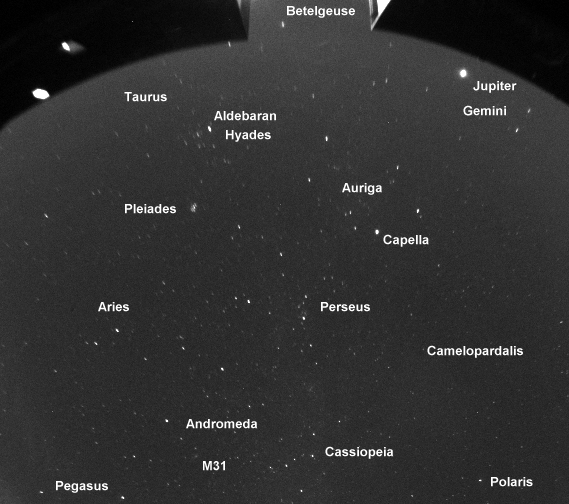
|
|
|
Back to Top
The AllSky Camera is a critical part of the Observatory, providing a live
realtime view of the night sky with information about cloud cover and the
numbers of stars visible.
Although a Cloud Sensor provides basic information about Rain & Clarity
(amount of clouds), it is poor at recognising high cloud which can cover
stars but not reduce the sky temperature (and thus not decrease the
CloudSensor's Clarity reading). The automatic star count provided by
my AllSky Camera Software fills this gap, and be used to close down observatory
operations when sky transparency is simply not good enough for observing.
My Observatory Control and AllSky Imaging Software talk to each other, and
allow for example the current telescope position and the positions of the next 3
telescope targets to be automatically added to AllSky Images.
Communication is performed between computers using TCP/IP ports. The
amount of cloud (if any) at the current and next 3 telescope targets are also
relayed back to the Observatory Control Software fo potential use in determining
a next course of action by the telescope.


Plot Showing AllSky StarCount vs Clarity for 18 hour and 5 day
intervals
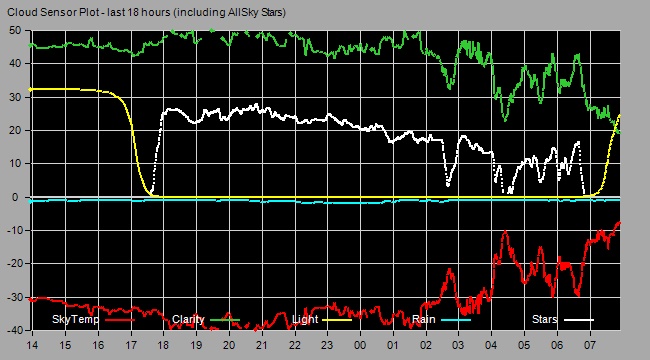

Back to Top
I am fortunate in having a clear view of most of the northern horizon from my
observatory in NE Scotland and can seen the Aurora Borealis several times a
year. Since 2014 I have been recording these auroral events with my AllSky
Camera and documentating them here. The number of
nights with observed Aurora activity per year depends on cloud cover and the sun's
activity level. In 2015 aurora were recorded on 21 nights, just
beating 2016 (19 nights).
The best ever Aurora display seen from my observatory occurred on the night of
27th/28th February 2014. It was a
great night ! One of the pictures from the night is shown below - just a
shame that the camera is monochrome only (for more pictures and a video
recording from this spectacular night go to
Aurora - 2014-02-27 /
2014-02-28).
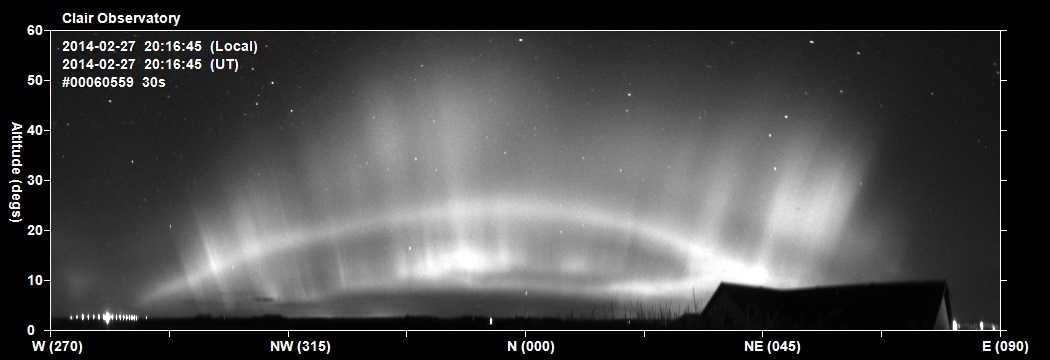
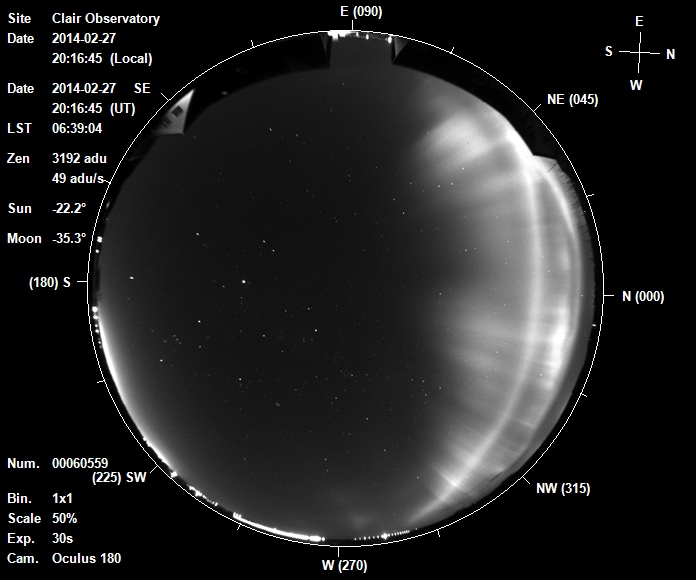
By taking a single N-S line from each image taen through the night and
placing them in sequence its possible to get a Night Summary Plot that
records the development of auroral activity and highlights its various
peaks.
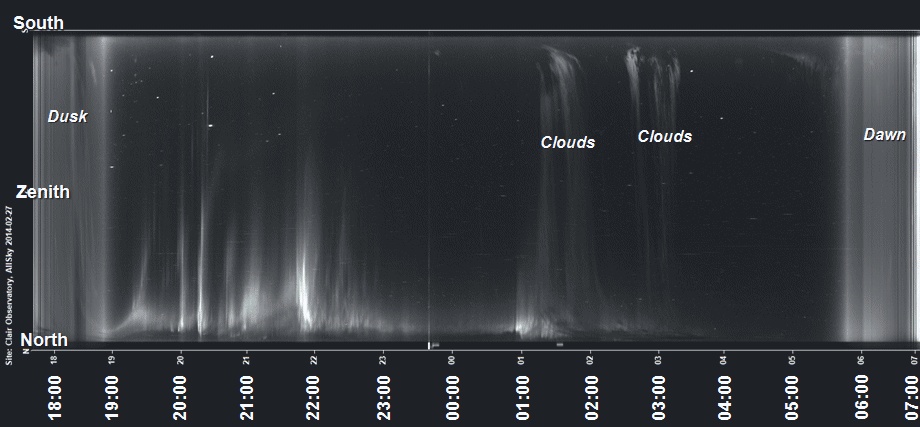
For more Aurora images and videos taken with my AllSky Camera go here.
Other notable Aurora Pictures
2015
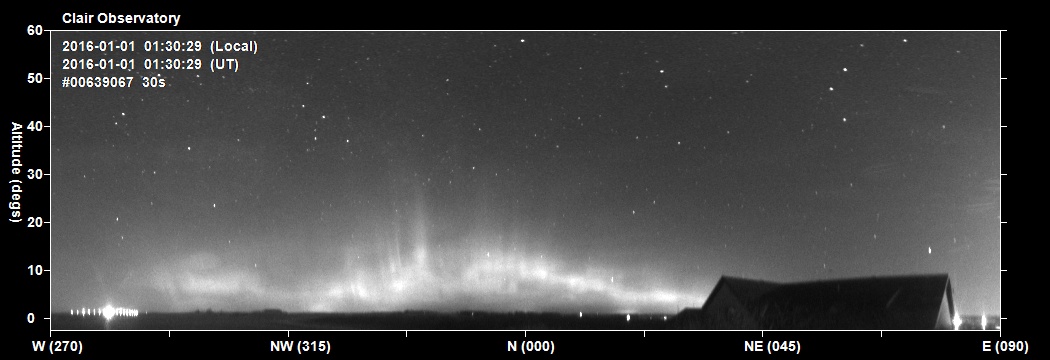
2016
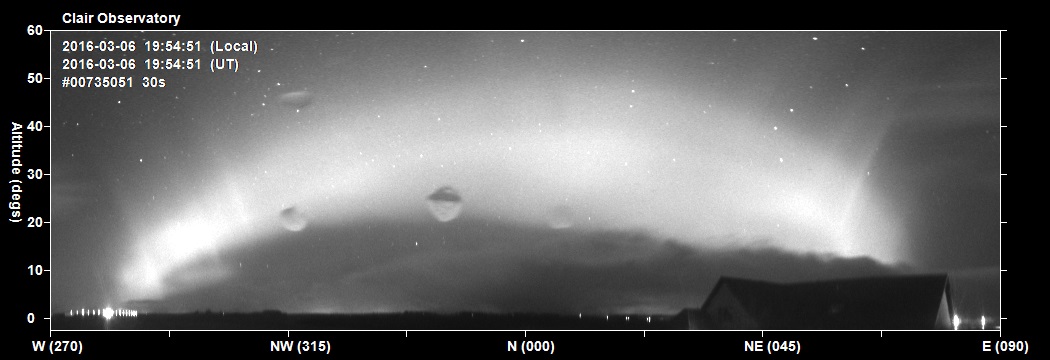
2019

Best Aurora Images and Videos
- Aurora - 2014-02-27 / 2014-02-28
- Aurora - 2015-04-09 / 2015-04-10
- Aurora - 2015-12-31 / 2016-01-01
- Aurora - 2016-03-06 / 2016-03-07
- Aurora - 2019-01-31 / 2019-02-01
Back to Top
The AllSky Camera will frequently pick up the movement of satellites across
the sky or sometime flaring when light bounces off their solar panels at just
the right angle. The number seen depends on the depression of the
sun below the horizon (and is thus a function of season)
Iridian Flares
Iridian Flare 2017-12-13 17:37h UT
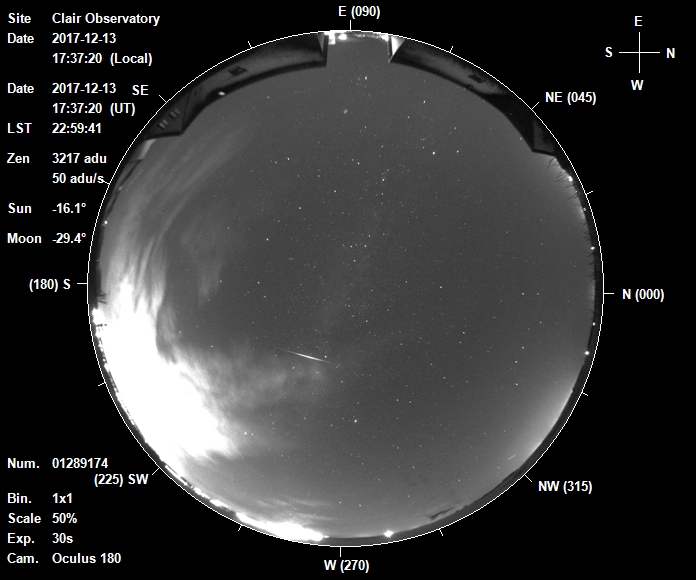

Planes
Rockets
De-orbital rocket burn on Atlas V rocket ,
2021-09-27, 21:11:22 to
21:16:32 UT
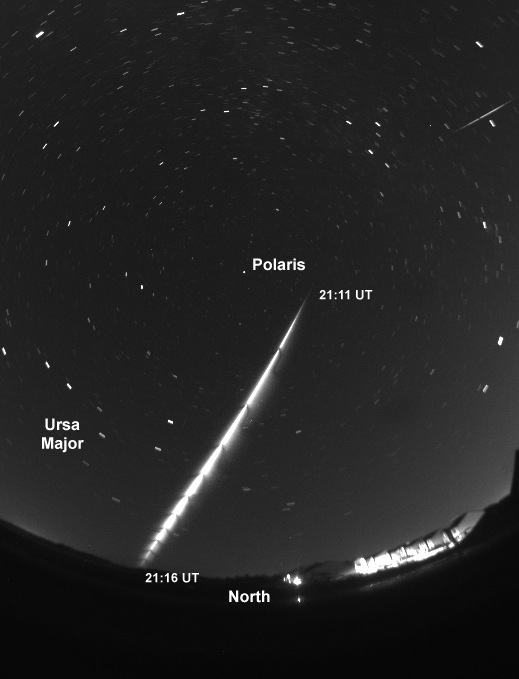
Back to Top
The camera is capable of picking up brighter meteors, but has trouble seeing
fainter ones due to their low S/N in 30s exposures than are nornally used.
Geminids
Geminid Meteor - 2017-12-14 05:46hUT
(geminid meteor radiant marked with white
cross)

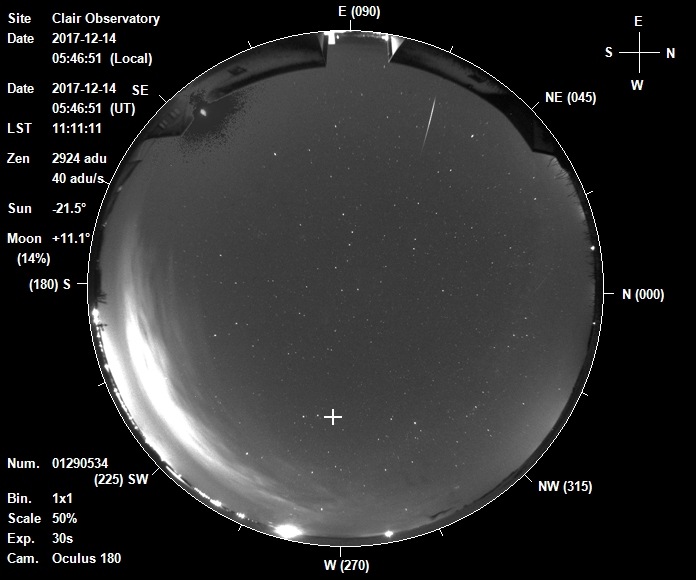
See more images Geminid
Meteors 2017-12-13 / 2017-12-14
Leonids
Leonid Meteor - 2017-11-17 04:16hUT
(Image taken with Oculus All Sky Camera) |
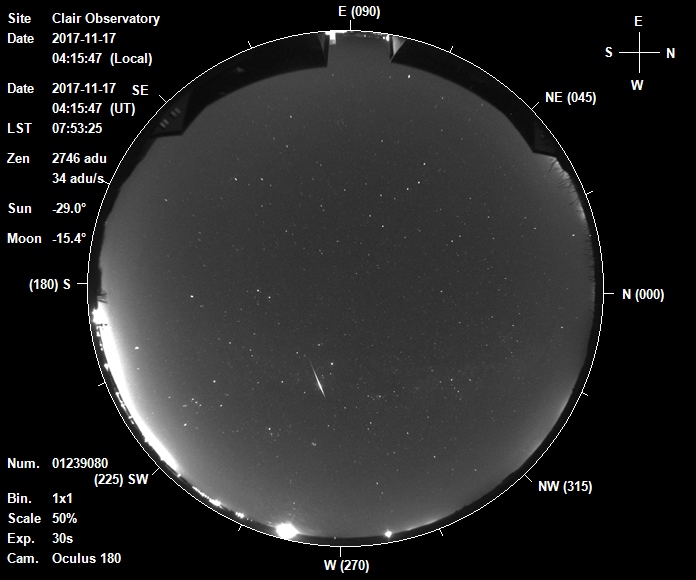 |
Annotated All Sky Camera Image (50%, cropped)
See picture for details on time/exposure
[
Alt Image
] |
| |
Leonid Meteor - 2017-11-17 04:16hUT
(Image taken with Oculus All Sky Camera) |
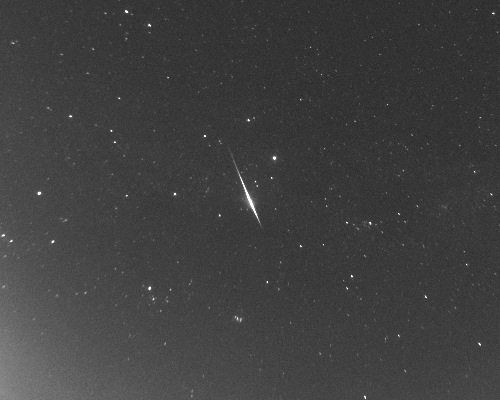 |
All Sky Camera Image (100%, cropped)
|
Leonid Meteor - Detail
The approximate radiant for the
Leonids is shown by a white cross (X)
The meteor is consistent with
this radiant and confirms the meteor as a leonid |
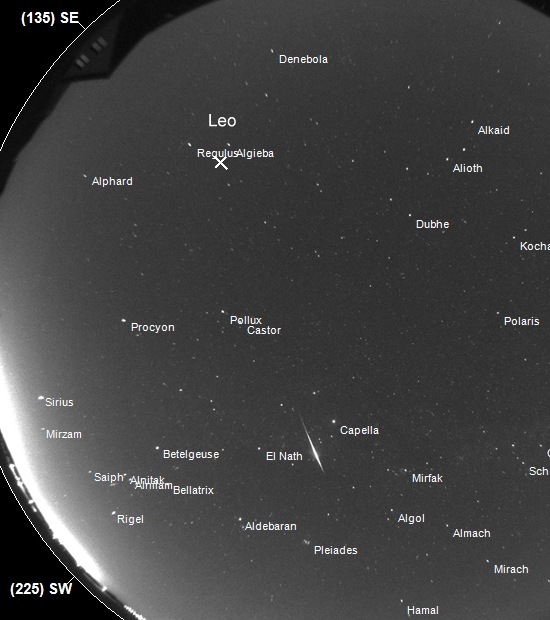 |
Annotated All Sky Camera Image (75%, cropped)
Image details as above
[
Full
Size ] |
| |
Other
| Bright Meteor in NW Sky at 2023-11-30 17:21 UT |
| |
 |
North Sky Panoramic Image
30s exposure (single frame)
2023-11-30 17:21:00 to 17:21:30 UT
Oculus AllSky Camera |
NE Scotland Bollide (2016-02-29)
At around 6:45pm (18.45hUT) on 2016-02-29 a
bright meteor crossed NE Scotland and exploded in a bright
flash. The sight was witnessed by multiple witnesses and
webcams across NE Scotland. The light appears to
have been seen as far south as Berwickshire in the Scottish
Borders and Newcastle.
The sky was unfortunately overcast at my observatory site and the meteor was not
directly imaged with my All Sky Camera, however a noticeable brightening of the sky
was observed in a 21sec exposure covering the period
18:45:40 to 18:46:01. This corresponds with the reported
time of the bollide exploding.

See more details/images on Bollide Event
2016-02-29.
Fireball (2022-09-14)
A bright fireball due to the passage of a meteor through the
earth's atmosphere occurred in the evening of 2022-09-14 passing rougly SSE
to NNW across North Wales and Northern Ireland.
The event has been documented by the UK Meteor Network https://twitter.com/UKMeteorNetwork/status/1570461868019392512 . Whilst it was initially though to represent rentry of
spacecrafet/rocket debris, later analysis indicated that it was
caused by a meteor.
Despite somewhat cloudy conditions the fireball event was detected in two
AllSky Cameras in Aberdeenshire (NE Scotland) lying in SW-WSW sky at
an altitude angle of 6-7 degrees and at a distance of some 330 km.
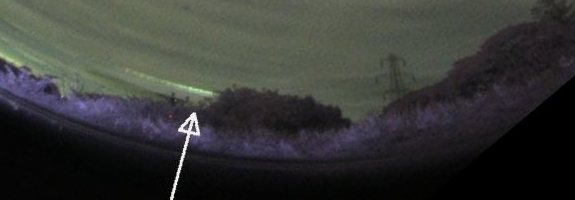
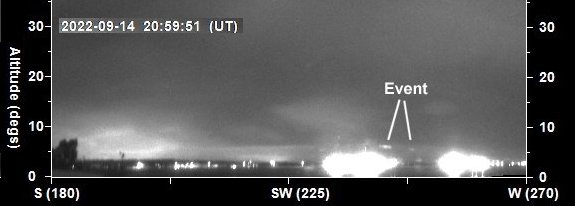
Image left by Neal Weston (2022-09-14 20:59:15 to 20:59:55 UT).
Image to right by David Richards (2022-09-14 20:59:51 to 21:00:21)
See more details/images on
Fireball Event 2022-09-14
Aurora and Meteor (2016-01-01)
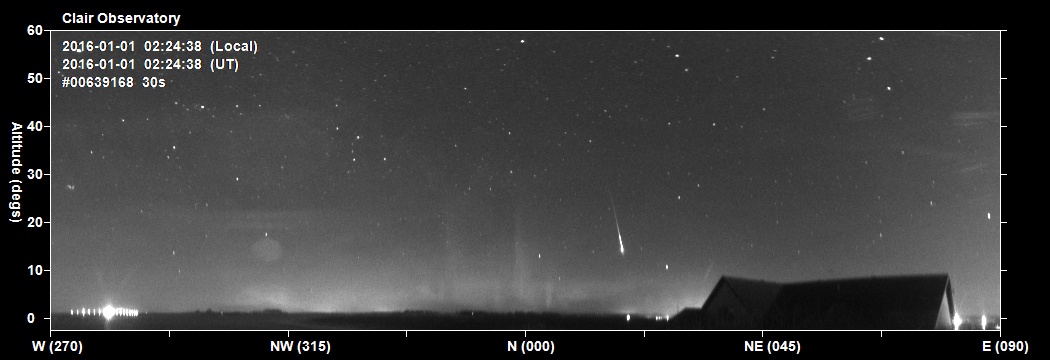
Back to Top
The camera has recorded a number of other atmospheric phenomena during its
years of operation, such as MoonBows,
Light Pillars,
NLC,
Lightening & other Weather. Some examples are shown below.
Moonbows
Moonbow - 2018-08-25 01:30 Local Time (BST)
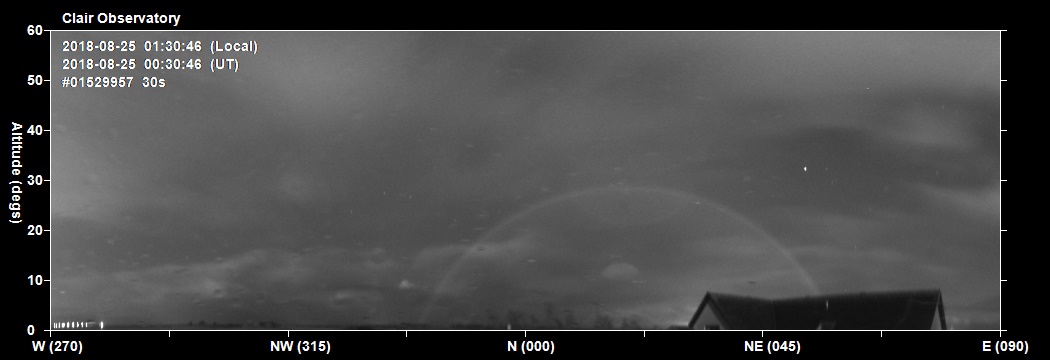
See more Moonbow pictures
2018-08-24.
Light Pillars
Light Pillars - 2016-11-02 22:47h UT (GMT)

See more
Light Pillar Pictures
2016-11-02
NLC
The AllSky Camera is not particularly good for recording NLC and they
tend to be embedded in the atmospheric glare from Sun which is located at
only 8-9 degs below the northern horizon on mid-summer nights when NLC are
most active. The following image might be showing NLC but it could simply be
regular high clouds.
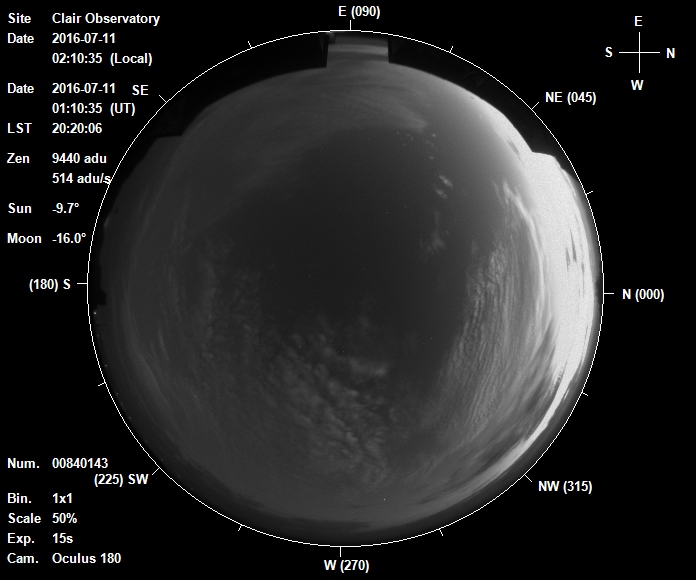

See more NLC Pictures 2016-07-10
Lightening
Lightning caught on All Sky Camera, 2016-07-20
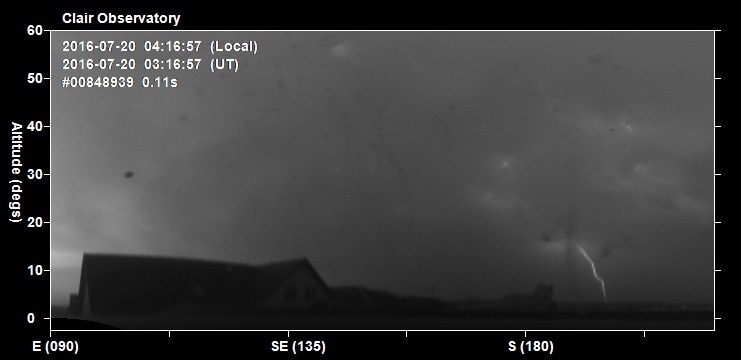
See more Lightning and Weather Pictures
Squall
A squall moving along northern horizon, 2015-05-27
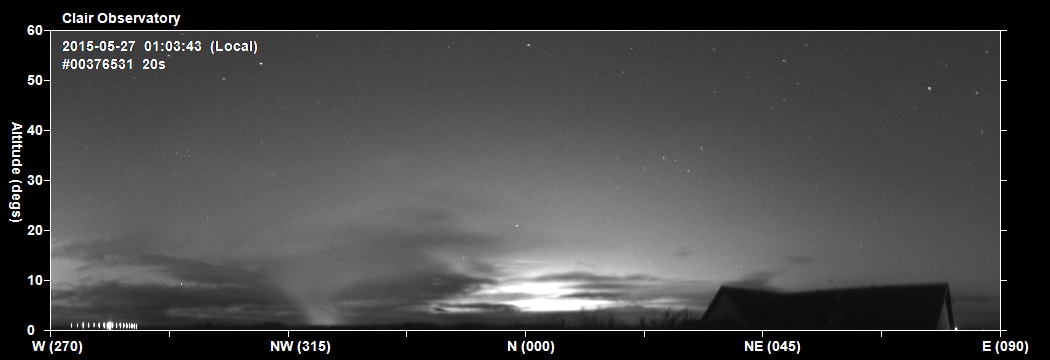
See more pictures of squall,
2015-05-07
Fireworks
Fireworks caught on All Sky Camera, 2023-11-11. These pictures help to
understand/explain unexpected light artefacts
that were caught in
Telescope Images at around the same time

Back to Top
Insects, Bugs, Birds and other Wildlife are frequently recorded by the
All-Sky camera.
| Insects caught on All Sky Camera |
 |
| |
| Selection of Insect and spider images - June/July 2015 |
 |
|
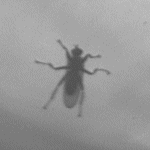 |
|
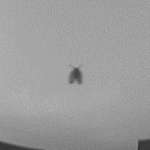 |
|
 |
| |
|
|
|
|
|
|
 |
|
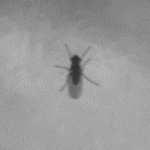 |
|
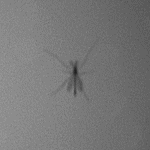 |
|
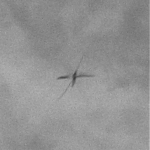 |
| |
|
|
|
|
|
|
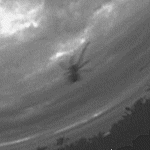 |
|
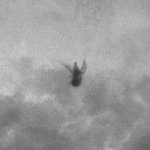 |
|
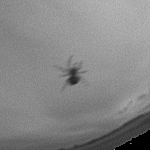 |
|
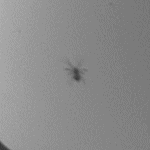 |
|
|
|
|
|
|
|
|
More pictures of inserts and other bugs
Back to Top
I use my own software (AstroAllSky) for the control and processing of images
from the camera.
As well as running 24x7 to capture and annotate AllSky images every 30s
from dusk to dawn each night, the software also automatically generates
panoramic pictures, night summary plots, videos and handles the upload of
images and videos to my website. The software also has functions to
regenerate pictures/charts from older historic images, and create
videos of selected parts of a night. There are also
functions for auto-calibrating the camera position/image geometry from one
or more specifically chosen star-filled images.
The software also creates difference images which can be useful for
tracking motion of clouds or satellites.
Back to Top
Links to specific notes concerning the AllSky Camera are listed below.
Back to Top






















































